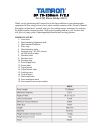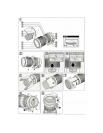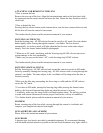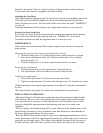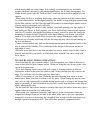which causes shadows on the image. It is strongly recommended to use a suitable
separate flash unit provided by the camera manufacturer for all flash photography. For
further details, please read the “built-in-flash” article on the instruction manual of your
camera.
-When using the lens in telephoto focal range, please be cautious with the camera shake.
To avoid camera shake, for the digital cameras, use an ISO setting of higher numbers and
for the film cameras, use the film with high ISO numbers to obtain higher shutter speeds.
Using a tripod or monopod is also effective.
When hand-holding the camera to take pictures, stand still opening your legs slightly a
part, hold your elbows in firmly against your chest, and hold the camera firmly against
your face. If possible, lean against something to steady yourself or place the camera on
something to secure the hold. Especially when hand-holding your camera, you will be
steadier if you hold your breath while you press the shutter button gently and firmly.
-When set on AF mode, interfering with the focusing ring may cause serious damage to
the lens mechanism.
-Certain camera models may indicate the maximum and minimum aperture values of the
lens in approximate numbers. This is inherent to the design of the camera and not an
indication of error.
-Please be aware that there is no infrared index line on any models listed in this owner’s
manual, and therefore, practically no black-and-white infrared film can be used with
these lenses.
TO ENSURE LONG-TERM SATISFACTION
-Avoid touching the glass element surface. Use photographic lens cloths or blowers to
remove dust from the lens element surface. When not using the lens, always place a lens
cap on it for protection.
-Use a lens cleaning tissue or lint cloth with a drop of cleaning solution to remove
fingerprints or dirt on the glass lens surface with a rotary motion from the center to the
edge. Use a silicone cloth to clean your lens barrel only.
-Mildew is an enemy of your lens. Clean the lens after shooting near water or in any
humid place. Store your lens in a clean, cool, dry place. When storing the lens in a lens
case, store it with commercially available drying agents such as silicagel, and change the
agent occasionally. If you find mildew on your lens, consult an authorized repair shop or
nearby photographic store.
-Do not touch the lens-camera interface contacts since dust, dirt and/or stains may cause a
contact failure between the lens and camera.
-When using your equipment [camera(s) and lens(es)] in an environment where the
temperature changes from one extreme to the other, make sure to put your equipment
temporarily in a case or plastic bag for a length of time in order for the equipment to go
through a gradual temperature shift. This will reduce potential equipment trouble.



